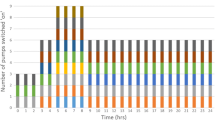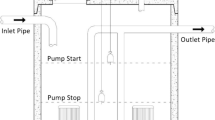Abstract
This paper presents a new methodology for optimizing the operation of pumps supplying water from a low source to an elevated tank in water distribution systems (WDSs). It is based on the use of the on/off trigger level technique for each pump present in the pumping station. The novelty of the methodology consists of the addition of time slots for the optimization of the trigger levels. These slots are created at the end of each energy tariff period, to drive the tank level to the highest and lowest points at the beginning and at the end of the peak, respectively. As a result, pumps are led to work more and less during low and high tariff periods, respectively, yielding reductions in energy costs. In the applications, the methodology was introduced within a multi-objective optimization framework, searching for solutions in the trade-off between daily average energy cost and daily average number of pump switches, representative of the stressing conditions for the system. The methodology was applied to case studies with single and multiple pumps, using realistic demand patterns, and was compared with other trigger levels-based methodologies in the scientific literature. The results proved its benefits, in yielding solutions with reduced number of pump switches for prefixed values of energy cost. This is more evident when the operation of three pumps must be optimized. In an explicative example with three operating pumps, for an energy cost around 6000 €/day, the newly proposed methodology leads to a number of pump switches between 17% and 33% lower than the results obtained with the methods considered for comparison.






Similar content being viewed by others
References
Alvisi S, Franchini M (2017) A robust approach based on time variable trigger levels for pump control. J Hydroinf 19(6):811–822
Blinco LJ, Simpson AR, Lambert MF, Marchi A (2016) Comparison of pumping regimes for water distribution systems to minimize cost and greenhouse gases. J Water Resour Plan Manag 142(6):04016010
Boulos PF, Wu Z, Orr CH, Moore M, Hsiung P, Thomas D (2001) Optimal pump operation of water distribution systems using genetic algorithms. In: Distribution system symposium
Boulos PF, Jacobsen LB, Heath JE, Kamojjala S (2014) Real-time modeling of water distribution systems: a case study. J Am Water Works Assoc 106:E391–E401
Castro-Gama ME, Pan Q, Salman S, Jonoski A (2015) Multivariate optimization to decrease total energy consumption in the water supply system of Abbiategrasso (Milan, Italy). Environ Eng Manag J (EEMJ) 14(9)
Castro-Gama M, Pan Q, Lanfranchi EA, Jonoski A, Solomatine DP (2017) Pump scheduling for a large water distribution network. Milan, Italy. In: Procedia engineering. Special issue of the WDSA2018 conference, vol 186, pp 436–443. https://doi.org/10.1016/j.proeng.2017.03.249
Creaco E (2017) Exploring numerically the benefits of water discharge prediction for the remote RTC of WDNs. Water 9:961 MDPI
Creaco E, Lanfranchi E, Chiesa C, Fantozzi M, Carrettini CA, Franchini M (2016) Optimisation of leakage and energy in the Abbiategrasso district. Civ Eng Environ Syst 33(1):22–34
DeMoyer R, Horwitz LB (1975) A system approach to water distribution modeling and control. Lexington Books, Lexington
Goryashko AP, Nemirovski AS (2014) Robust energy cost optimization of water distribution system with uncertain demand. Autom Remote Control 75(10):1754–1769
Hadka D, Reed P (2013) Borg: an auto-adaptive many-objective evolutionary computing framework. Evol Comput 21(2):231–259
Housh M, Salomons E (2018) Optimal dynamic pump triggers for cost saving and robust water distribution system operations. J Water Resour Plan Manag 145(2):04018095
Jung D, Kang D, Kang M, Kim B (2015) Real-time pump scheduling for water transmission systems: case study. KSCE J Civ Eng 19:1987–1993
Kang D (2014) Real-time optimal control of water distribution systems. CCWI 2013. Procedia Engineering 70:917–923
Kazantzis MD, Simpson AR, Kwong D, Tan SM (2002) A new methodology for optimizing the daily operations of a pumping plant. In: Proceedings of the 2002 conference on water resources planning
Khatavkar P, Mays LW (2017) Model for optimal operation of water distribution pumps with uncertain demand patterns. Water Resour Manag 31:3867–3880. https://doi.org/10.1007/s11269-017-1712-8
Lopez-Ibanez M, Prasad TD, Paechter B (2005) Multi-objective optimisation of the pump scheduling problem using SPEA2. In: Evolutionary computation, 2005. The 2005 IEEE congress on, vol 1. IEEE, pp 435–442
Luna T, Ribau J, Figueiredo D, Alves R (2019) Improving energy efficiency in water supply systems with pump scheduling optimization. J Clean Prod 213:342–356. https://doi.org/10.1016/j.jclepro.2018.12.190
Mackle G, Savic D, Walters G (1995) Application of genetic algorithms to pump scheduling for water supply. GALESIA 1995, Institute of Electrical Engineers, pp 400–405
Mala-Jetmarova H, Sultanova N, Savic D (2018) Lost in optimisation of water distribution systems? A literature review of system design. Water 10(3):307
Marchi A, Simpson AR, Lambert MF (2016) Optimization of pump operation using rule-based controls in EPANET2: new ETTAR toolkit and correction of energy computation. J Water Resour Plan Manag 142(7):04016012
Paschke M, Spencer K, Waniarcha N, Simpson A, Widdop T (2001) Genetic algorithms for optimising pumping operations. 19th Federal Convention, Australian Water Association, Canberra, Australia, April
Pasha MFK, Lansey KE (2009) Optimal pump scheduling by linear programming. In: Proceedings of World Environmental and Water Resources Congress 2009: Great Rivers, vol 342, p 395404. https://doi.org/10.1061/41036(342)38
Rao Z, Salomons E (2007) Development of a real-time, nearoptimal control process for water-distribution networks. J Hydroinf 9(1):25–38
Savic D, Walters GA, Schwab M (1997) Multiobjective genetic algorithms for pump scheduling in water supply. In: AISB international workshop on evolutionary computing. Springer, pp 227–235
Sterling MJH, Coulbeck B (1975) A dynamic programming solution to the optimisation of pumping costs. Proc ICE 59(2):813–818
Stokes CS, Simpson AR, Maier HR (2012) An improved framework for the modelling and optimisation of greenhouse gas emissions associated with water distribution systems. In: International Congress on Environmental Modelling and Software, Leipzig, Germany
Van Zyl JE, Savic D, Walters GA (2004) Operational optimization of water distribution systems using a hybrid genetic algorithm. J Water Resour Plan Manag 130(2):160–170
Walski T, Creaco E (2016) Selection of pumping configuration for closed water distribution systems. J Water Resour Plan Manag 142(6):04016009
Author information
Authors and Affiliations
Corresponding author
Ethics declarations
Conflict of Interest
None.
Additional information
Publisher’s Note
Springer Nature remains neutral with regard to jurisdictional claims in published maps and institutional affiliations.
Rights and permissions
About this article
Cite this article
Quintiliani, C., Creaco, E. Using Additional Time Slots for Improving Pump Control Optimization Based on Trigger Levels. Water Resour Manage 33, 3175–3186 (2019). https://doi.org/10.1007/s11269-019-02297-6
Received:
Accepted:
Published:
Issue Date:
DOI: https://doi.org/10.1007/s11269-019-02297-6




